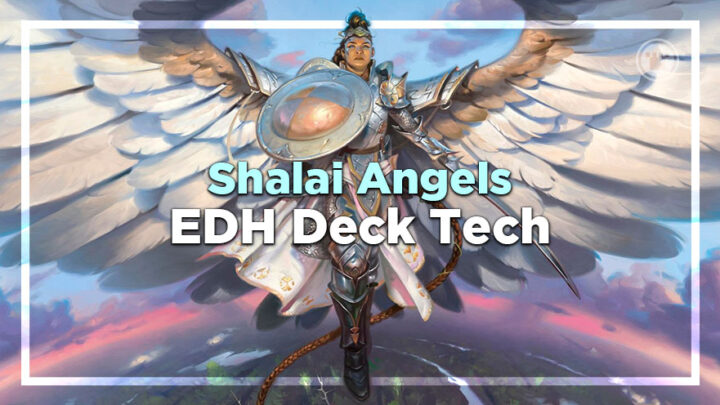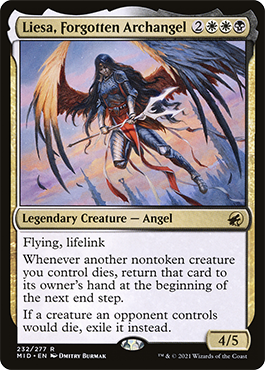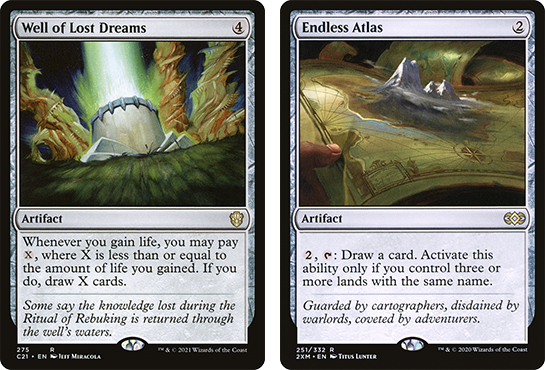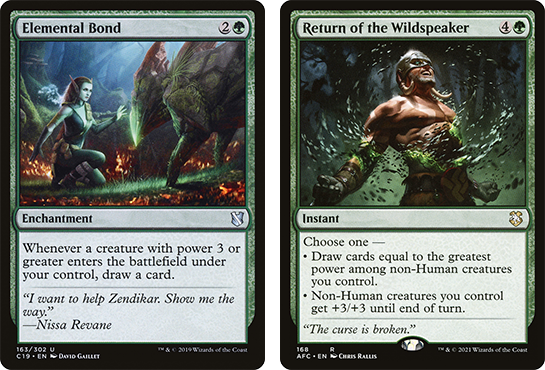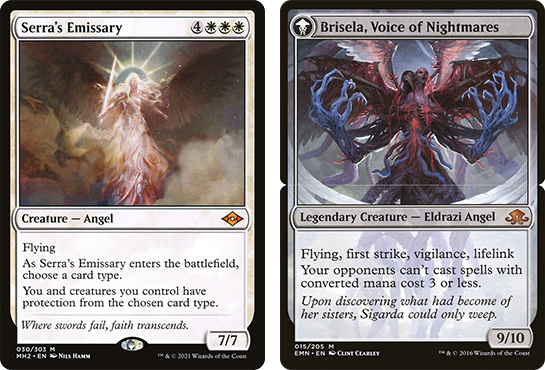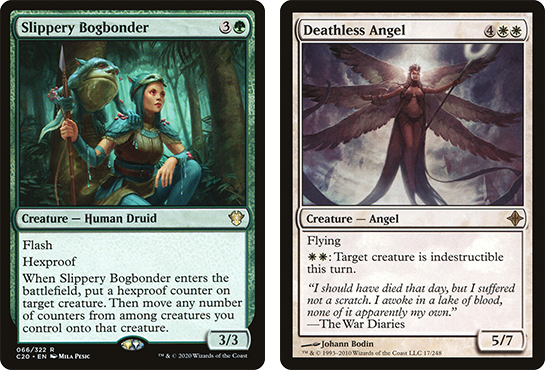Kristen has spent some time tuning up her decks recently, and it turns out that the lack of explosiveness in one deck has prompted a complete rebuild. She takes us over how adding some explosiveness to Commander decks can really ramp up their win potential.
It’s been a little while since I last checked in with y’all on what I’ve been brewing and playing, and it seemed like a good time to check in. Most recently, I shared my Liesa, Forgotten Archangel deck with you. It’s a value-based reanimator deck, and it was born from a brewing journey which you can read about in depth over here. The deck is a blast to play, and I can tell you that I’ve managed to assemble Brisela plenty of times.
I have a bit of a thing for playing Angel decks – I like their ability to achieve aerial dominance and end games through combat, and I like the lore aspect – and my original tribal build was Lyra Dawnbringer. If you’ve been keeping up with my column, you’ll know I recently spoke too on how casual mono-white’s main issue was that it couldn’t perform explosive turns. Well, the day finally came when it was time to revisit Lyra, as the deck wasn’t bringing me joy.
Just Add Green
As much as it pains me to say it, the solution to many of mono-white’s problems is simple: Just Add Green™.
Now that I’ve got that out of the way, I’ll take you through my logic in more depth. Green offers a wealth of advantages to building an expensive tribe with a higher mana curve, not least the ability to ramp into the threats you want to play.
One of the main hurdles non-specific white decks run into is drawing enough cards. If you’re running life gain you have some options, and if you’re making small tokens, there’s always Skullclamp and Welcoming Vampire.
Other than Sram and Losheel, card draw is thin on the ground, and so tapping out to play an Angel and not drawing cards to replace it is really not the best place to be. My Lyra list, last I looked, was split between playing the Angel creatures I wanted to play, and making tokens. The tokens served two main purposes; they were a good way to go wide and convert damage, and they were a way to accrue a board state with minimal card investment, which is kind of necessary in mono white. The rest of the deck had a lot of recursion and protection, because, well, you have to secure your investment, especially when you can’t reliably draw into more creatures every game.
Just as green gives us the mana to cast expensive Angels, it also lets us replace them by giving us plenty of options for card draw. It’s a great choice if you feel like your mono-white deck is struggling to keep up at casual tables in 2022.
Green Offers More Than Ramp
It’s a common misconception that green offers only ramp and draw, but there were other reasons to dip into green that benefit an Angel tribal deck, too:
- Tutors – While white can play Search for Glory, it can’t tutor creatures very well otherwise. Green gives Eladamri’s Call, Chord of Calling, Natural Order, and many more useful ways to get the Angel you need.
- Protection – While white is indeed the best color for protection, green offers some really useful and efficient options, like Heroic Intervention and Tamiyo’s Safekeeping.
- Multi-taskers – Selvala, Heart of the Wilds, The Great Henge, Mirari’s Wake; they all offer mana advantage with other effects. Green can give more bang for your buck when it comes to cramming in utility to deck slots.
- Lifegain Synergy – lifegain is divided between the colors in the Abzan part of the color pie, and green has some cracking ways to take advantage of lifegain, from Trudge Garden to Lathiel, the Bounteous Dawn.
- Utility Lands – Castle Garenbrig, Gavony Township, Bala Ged Recovery, even Mosswort Bridge are great ways to inch out more advantage.
I’d already decided on building an Angel tokens deck when I got done building Liesa, Forgotten Archangel, so I decided it was time to retire Lyra, moving the token generation to this other brew. That left me with a pile of Angel cards I loved to play that needed a new home, and that new home was absolutely a GW deck. Enter Shalai.
Shalai, Voice of Plenty – Explosive Angles
Whilst the best way to guarantee consistency in a game of EDH is to pick a Commander with card advantage or ramp in the command zone, it’s sometimes not the most flavorful or fun choice. So, whilst Karametra, God of Harvests or Selvala, Explorer Returned might have been the more consistent choices, they weren’t right for what I was trying to put together.
Shalai offers card advantage in another way: through making your board – and you – very difficult to interact with. By adding a way to keep Shalai safe, like Lightning Greaves, you can have a board that only falls to board wipes – and there are plenty of tools to stop those, too, from Teferi’s Protection to Avacyn, Angel of Hope.
What’s the Gameplan?
This build was as much an experiment to test out what I suspected about the format as it was a chance to enjoy the cards I like to play. It’s been my experience over the last year or so that games seem to be ending a turn or two sooner than they used to (or at least, the writing is on the wall at that point in the game).
Decks are a lot more focused on making their strategy as explosive as possible, sacrificing deckbuilding slots that ordinarily would be spent on control and recursion, in order to maximize their chances at pulling off their strategy. It’s an approach that isn’t exactly new to the format; the Kaalia of the Vast decks of old leaned hard into this, running all of the mana rocks they could to ensure an early Kaalia.
This line of thinking – emboldened and explored further through appreciation and consumption of content – has led to the middle-ground of the format feeling a lot more tuned than it used to! You might argue this would have happened naturally anyways to an extent, what with the lifecycle of players picking up and learning the format, and natural power creep, but what’s important is that it’s a fact of how things are.
What does this mean for the average Casual Commander player? Well, the grindy, recursive decks of yesteryear are less relevant. I can tell you that empirically, having had problems with my Lyra deck, and even a casual Meren deck I hadn’t updated for a few years. As long as a game was able to get to turn 11+, my confidence that I could close it with Lyra got higher and higher. Unfortunately, games tend to end between turn 7-8 far more often now, and after a board wipe and a little removal in the mid-game, Lyra struggled to recommit to the board and offer a winning position. Mono-white lacks options for mass haste, mass draw, or unblockable, making combat a struggle in the face of back-to-back removal. In short, white couldn’t be explosive.
My Shalai build sought to solve this problem by assembling an impenetrable board as quickly as possible, before pivoting to finishing the game through combat. The deck is less of a reanimator deck than it used to be, and far more in the realm of stax-”lite”. It doesn’t really slow people down, as such, but seeks to provide a puzzle to solve.
The key to its success, meanwhile, is a number of powerful and swingy cards.
A Series of Cute Angles
I can’t discuss the rest of the cards in the deck without talking about two of the most fun – and powerful – cards to cast: Kindred Summons & Selvala’s Stampede. I’ll go over the latter, first.
Selvala’s Stampede has long been in my collection, designated firmly as “jank”. In previous years, I’d dismiss this kind of card, as the time and mana it took to cast it was less meaningful in games that regularly went over 10 turns, and with decks that drew far fewer cards, on average. The downside of the card is obvious; if you have a small hand, people will all vote for you to drop your hand into play.
This card has, in my humble opinion, gone from a never-play to a firm “Huh, that’s pretty good” in recent times. It helps when some of the permanents I can drop in from hand are Akroma’s Memorial, The Great Henge, or Elspeth Conquers Death, sure, but we’re playing this because it lets us assemble the Shalai puzzle at a faster rate, sometimes letting us luck-sack into our best Angels.
One of the reasons I love a good Living Death so much is that it can let you shortcut to hilarious and powerful board states. GW can’t do that, not exactly, but these green spells can come close.
Kindred Summons does require some Angels in play, but getting to go dig for them – while bypassing our utility creatures – can be such a huge tempo swing. It’s such a key part of the deck’s strategy that we run some other ways to achieve the same thing: Chord of Calling to tutor into play at Instant speed; Vivien, Monster’s Advocate, who can grab us a second angel; and Pyre of Heroes, which lets us pod through to what we need. Even Rishkar’s Expertise can do solid work here, letting us dig for what we need before casting it.
There are more cute angles when it comes to protecting the board. Slippery Bogbonder is incredible for a Shalai deck; not only does it provide a very hard to interact with way of granting Shalai Hexproof, it also lets us move accrued +1/+1 counters onto our Commander for Commander Damage wins.
Deathless Angel is a card I haven’t played since the days I ran Kaalia, and the reason she’s back off the bench is that she gives us multiple chances at keeping our board intact on one card. Having an activated ability that can sit behind Shalai’s hexproofing is invaluable to our strategy, and a 5/7 body is also pretty strong.
Our protection package is also pretty versatile in other ways. Totem armor protects from board wipes, so I’ve splashed out for the most explosive one of them all: Bear Umbra. Feast & Famine doesn’t make it in this build, but I like Bear Umbra a lot. Ephemerate over Blacksmith’s Skill is an interesting one, but one you’ll understand when looking through the deck: we have a series of good enters-the-battlefield effects that are worth resetting, like Serra’s Emissary and Angel of the Ruins.
I opted for Aura Shards to get the most out of playing expensive creatures. We’re not a blink deck so it’s not too oppressive, but what makes it truly worth playing is how it interacts with some of our other game pieces.
Liquimetal Torque, one of the two drop rocks in the deck, can turn things into artifacts. This works great with Aura Shards, and with Sword of Sinew and Steel – a sword I picked because the pro-red is super relevant in protection from board wipes that might hit Shalai or our other valuable Angels.
Though it’ll probably go through a few further drafts, testing out the likes of Mirari’s Wake – my only copy is in my enchantress deck – I’m happy with the list as it stands, and it’s a lot of fun to play.
Whilst a Shalai Angel tribal deck isn’t a new concept, I think the takeaway here is understanding just what adding green can do for mono-white decks, and, perhaps even more importantly, what adding explosiveness to a deck can do. It’s not just about winning games, but being able to “do the thing”. You need to run some amount of “all-in” cards to achieve this more consistently. Sometimes they won’t do what you want, but other times? They’re a hoot. Sneak Attack is one I think people should be playing a lot more of, and it’s going into my latest brew: Hofri Ghostforge. Perhaps I’ll share that one too.
How are you building your Angel decks? Is GW enough? Have you tried a Naya build with Samut, or even a Rule 0 five-color deck led by Maelstrom Archangel? Let me know on Twitter.

Kristen is Card Kingdom’s Head Writer and a member of the Commander Format Panel. Formerly a competitive Pokémon TCG grinder, she has been playing Magic since Shadows Over Innistrad, which in her opinion, was a great set to start with. When she’s not taking names with Equipment and Aggro strategies in Commander, she loves to play any form of Limited.

